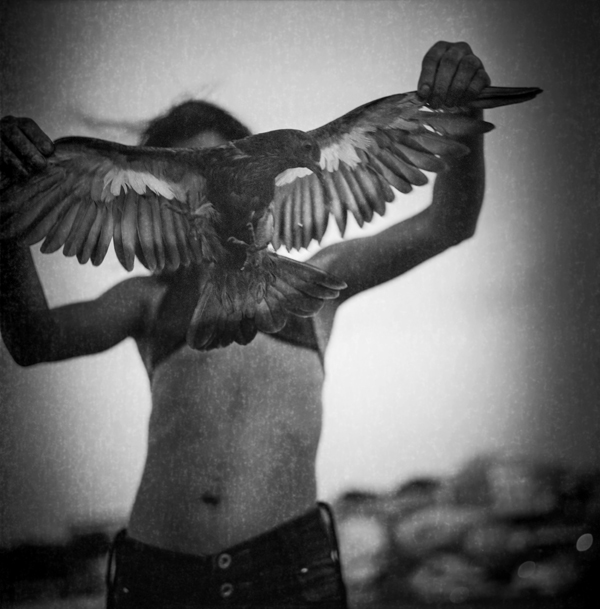Raphael Alves: Riversick
 © Raphael Alves
© Raphael Alves
About The Exhibition
Curator: Lara Ciarabellini
This exhibition includes images, curatorial statement, information on the photographer and two videos by Raphael Alves (Se essa rua fosse minha and Antitese Amazonida).
"Riversick" is a work about how people and nature share the space in Manaus (the biggest city in the Amazon region, Brazil). Manaus is the Amazonas state capital and the main financial center, corporate and economic development of northern Brazil. It is a historical and port city, located in the center of the largest rainforest in the world. It is located at the confluence of the Negro and Solimoes rivers. It is the most populous city in the state of Amazonas and in the Amazon, with a population of over two million inhabitants. Still, the geographical distance to the major centers of the country, keep the city not very known on the national scene. Sometimes I think that “Caeiro’s village” is exactly the place where I live in. I was born by the river. I grew up by the river. And though I have moved for some years to study, my life is still by the river. After photographing Manaus for a while (and I am still shooting) I realized my body of work could approach the relation people in the urban areas have with nature, notably with water. The name of the series comes from a paronomasia of the words "homesick" and "seasick" - 'River' because of the geographical location of Manaus (by two of the biggest rivers in the world - Solimões and Negro). And 'sick' meaning a feeling that varies between missing a place and nausea. |
|
"Riversick" é um trabalho sobre como pessoas e natureza compartilham o espaço em Manaus (a maior cidade da região amazônica, Brasil). Manaus é a capital do Estado do Amazonas e o principal centro financeiro e econômico da região norte do Brasil. É uma cidade histórica e portuária, localizado no centro da maior floresta tropical do mundo. Está localizada na confluência dos rios Negro e Solimões. É a cidade mais populosa do estado do Amazonas e na Amazônia, com uma população de mais de dois milhões de habitantes. Ainda assim, a distância geográfica para os principais centros do país mantem a cidade pouco reconhecida no cenário nacional. "Ninguém nunca pensou sobre o que está além do rio da minha aldeia. O rio da minha aldeia não faz pensar em nada. Quem está ao lado dele simplesmente está ao lado dele ", disse uma vez Alberto Caeiro. Às vezes eu penso que "a aldeia de Caeiro" é exatamente o lugar onde eu moro. Eu nasci perto do rio. Eu cresci perto do rio. E apesar de eu ter me mudado para outros lugares por alguns anos para estudar, minha vida ainda é próxima ao rio. Depois de fotografar Manaus por um tempo (e ainda estou fotografando). Eu percebi que meu corpo de trabalho poderia abordar as relações que as pessoas das áreas urbanas têm com a natureza, em especial com as águas. O nome da série vem de um trocadilho das palavras homesick ("saudades de casa") e (seasick) "enjoado por deslocamento sobre o mar" e 'river' (por causa da localização geográfica de Manaus, à beira de dois dos maiores rios do mundo - Solimões e Negro). |
© Raphael Alves, 2016
On VASA Exhibitions:
VASA Exhibitions over the years have provided a platform for individual and group exhibitions, collaborative exhibitions with various organizations and galleries and exhibitions that follow a particular theme or inquiry such as “Where Do We Go Now” curated by Rui Cepeda and the “Kharkiv School of Photography: Soviet Censorship to New Aesthetics” curated by Igor Manko.
VASA Exhibitions are international and multicultural. The curatorial team has strived to present work that not only represents the photographers but also the social, historical and cultural. As an online international project, VASA works to engage various digital tools. Video, as an example, not only offers the potential for the presentation of works, it provides the opportunity and framework for the voice of the author to be seen and heard. Through image, text, sound and animation, VASA works to expand the exhibition paradigm and provide a rich experience for the viewer (as well as the author).
VASA Exhibitions provides a viewing and research environment by archiving all of the exhibitions in their entirety. For example, the viewer may view a 2009 exhibition as it was presented and not just traces of its existence.
VASA Exhibitions includes video and video series, and sound works.